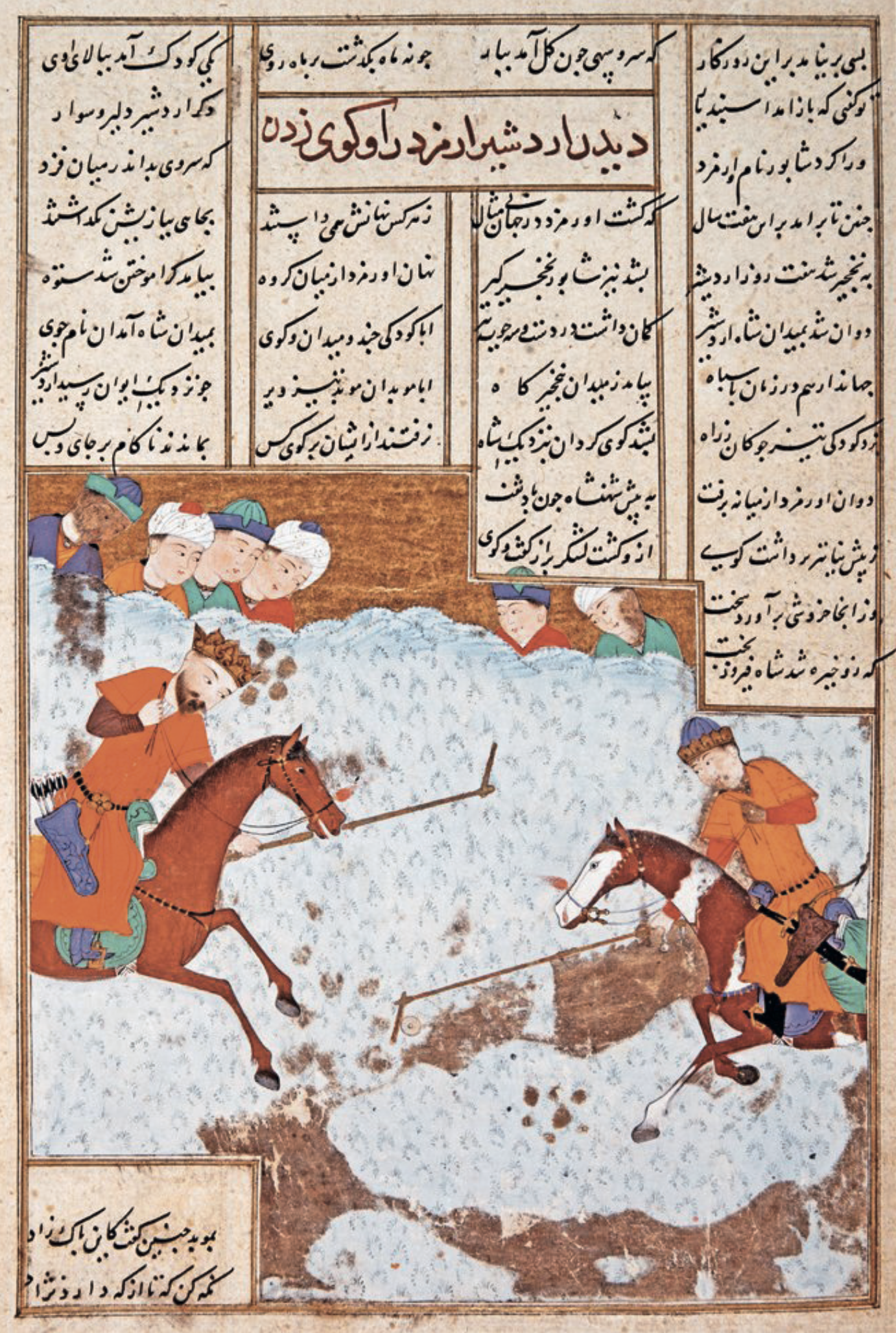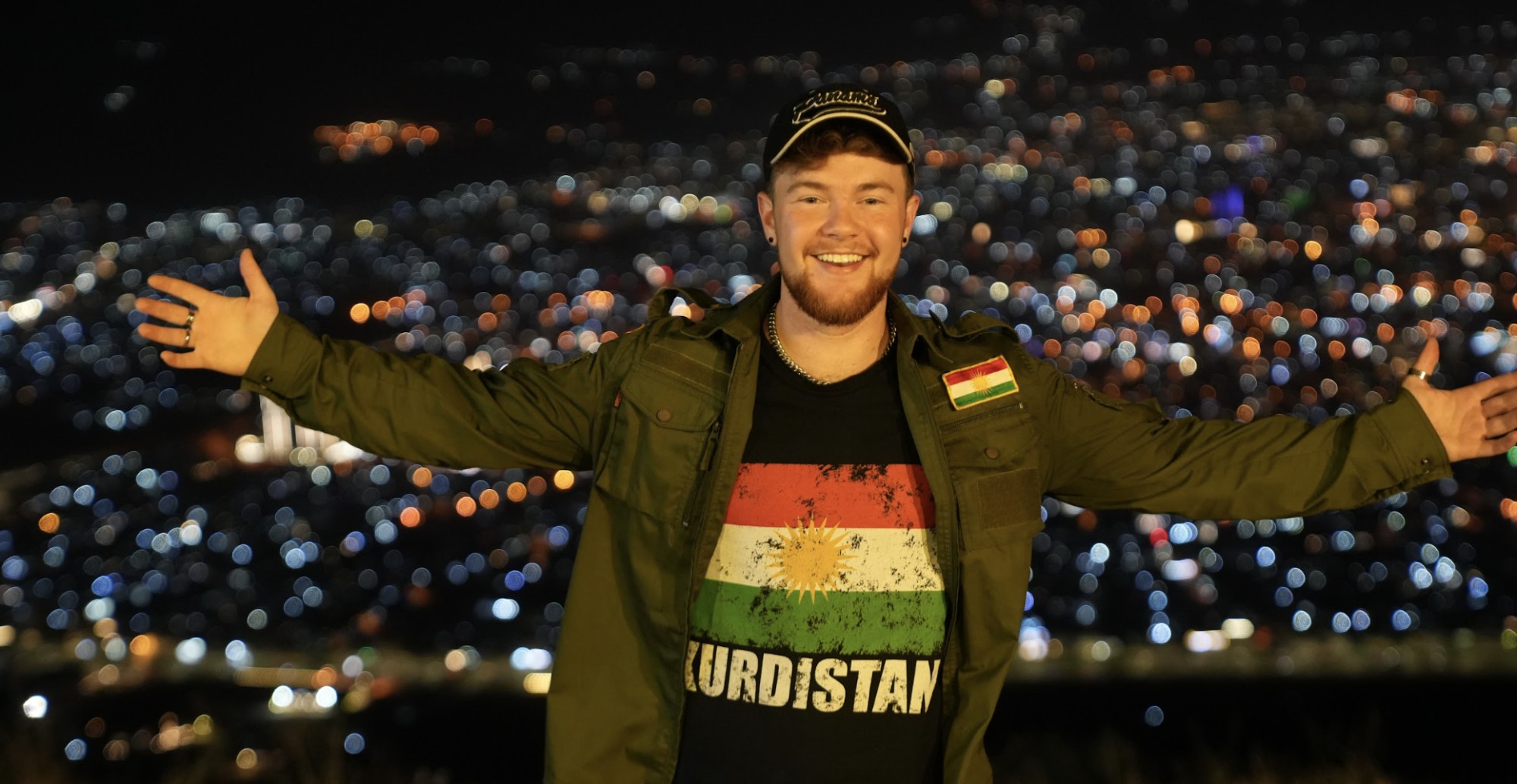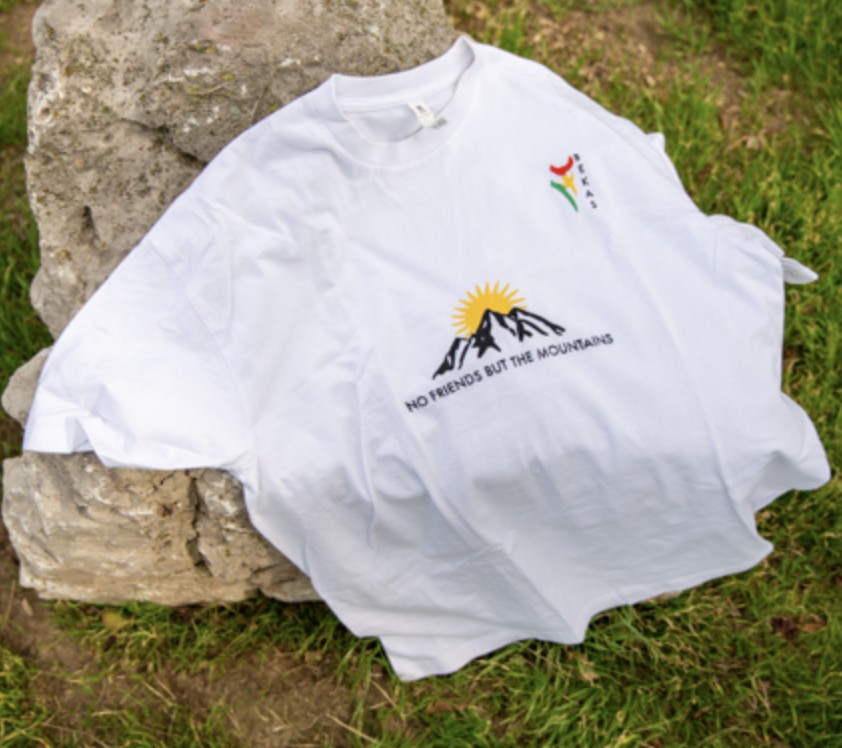The game of polo, chogan in Persian and gog in Kurdish, has its origins in Central Asia with roots in Iran dating to the period from the sixth century BC to the first century AD. It was initially a training game for cavalry units, particularly for the king's guard or other elite troops, and was considered a miniature battle by the warlike tribesmen who played it with as many as 100 people on each team.
Over time, it became a popular national sport in Persia. Historical records reveal that even the queen and her ladies engaged King Khosrow II Parvīz and his courtiers in the sixth century AD. Ferdowsi, the famous Iranian epic poet, gave several accounts of the royal chogan matches in his epic Shahnameh in the 9th century AD.
Polo also spread to other countries such as Arabia, Tibet, China, and Japan. It reached its peak of popularity in Persia during the Sassanid Empire (224-651 AD), where it was a favorite pastime of the ruling classes. It was also popular in the courts of the Kurdish principalities for centuries.

Polo in Kurdish courts
In the Middle Ages, polo spread from Persia to Byzantium. In the Islamic period, it spread among the Ayyubids and Mamluks in both Egypt and the Levant, where the elite preferred it to all other games. It is known that famous sultans, such as Salah al-Din al-Ayyubi and al-Zahir Baybars, played polo and encourage it to be played in their courts.
Playing polo was dangerous and often resulted in players’ deaths. One such story about the death of Najm al-Din Ayyub, the father of the sultan Salah al-Din, was narrated by Ibn Wasil al-Humaydi. "Najm al-Din was fond of playing with the ball and running with it, so everyone who saw him in this state would estimate that he would not die except from falling off a horse." And that's what happened!
Meanwhile, Imam Ibn Kathir tells us that “Nur al-Din brought Salah al-Din close and made him one of his close companions, and he would not separate from him, either when he was present or when he was traveling, because he was handsome and good at playing with the ball."
The Ottoman traveler Evliya Çelebi (1611-1682) in his book Siyahatnamah, offers a vivid description of polo among Kurds during his third visit to Bitlis Castle. When Çelebi saw the Chogan Court near the Sharaf Khan Mosque, he saw mounted soldiers and knights of the “Ruzki” tribe, who used to come there to show off their skills in chogan and galloping.
He exaggeratedly elaborated that there are stone pillars at either end of the field, where two teams of a thousand knights each knight holding a mallet of wood faced off against each other from opposing ends. They placed a round wooden ball the size of a human head in the middle of the field, and when the band began to play and the rhythm of the drums reached its apex, a man from each side would rush forward on horseback, trying to hit the ball towards his own goal. Another also rushed forward to hit the ball rolling towards his team's goal, and the ball then reached another knight, who hit it while it was in the air, and so on. The two armies fought, trying to hit the poor ball until it shattered into many pieces. Ultimately, one of them succeeded, and the losing team prepared a feast for the winners.
Polo was an amazing sight, and a great occasion to test fortitude, patience, and horsemanship. Sometimes it happened that the wands missed and hit the horse's legs, causing the poor pony or mare to become limp. But horses were so well trained that they chased the ball like cats after a mouse.
The game was also an excellent military exercise, although sometimes it degenerated into a real, blood-spilled battle for the ball. After the end of the game, the number of times that one of the two teams could bring the ball to his own goal are counted according to an agreed-upon number, say five or ten.
This equestrian sport is a favorite in both Kurdistan and Iran.

Polo among Kurdish nomads
Mahmoud Bayazidi (1797-1867?), in a letter to the Russian orientalist Alexander Jabba on the customs and traditions of the nomadic Kurds, mentioned another type of polo called hoal. He related how in the afternoons, the youth and the boys from the summer camps all gathered and played in front of the houses to play hoal or compete in running. On the other side, Diaa al-Din al-Maqdisi, the author of the dictionary of al-Hadiyah al-Hamidiyah, defined hoal as a game for boys, each of whom takes a stick and hits a ball among them.
My elder neighbors have related to me that a game called hoali was still being played on foot among villagers in the rural areas of the city of Kobani in the 1950s. As children, we also played a simple version of it in our backyards.
Here, we must distinguish between the term chogan meaning “mallet, playing stick” and hoal meaning “ball.”
On the other hand, Zeynelabidîn Zinar, a modern author, details a game called gog in his book Mîrate, explaining that there are two variations of this game: infantry gog and cavalry gog.
Infantry gog uses the ball (gog) and racket (kasho). The gog is made of sheep’s wool and ranges in size from a pigeon’s egg to a turkey’s egg. The kasho spans six lengths and has a handle at the top and a wide bottom for receiving the ball. The field (meydan) is flat and in the middle is a small hole (hochk), around which a large and wide circle is drawn and guarded by one player from one of two teams. While one team tries to get the ball into the hole, the other works to block them from doing so and batting the ball away outside that circle.
Cavalry gog, on the other hand, is played by horsemen with mallets and takes two forms. The first is like infantry gog, but the ball is larger, and the mallets are longer. The second differs in the size of the meydan, which is larger and rectangular in shape. On each side is a goal with a length of 15 to 20 meters, guarded by one player. The ball is placed in the middle of the field, and a team wins if the ball enters the opposing goal several times.
Polo in Kurdish literature
Kurdish men of letters have also referred to polo in their poetic works, employing its terms and tools to express overwhelming emotions and the sense of submission, according to the doctrine of fatalism, to the will of the beloved or the divine. To elucidate this, we only have to look closely at the collection of Mulla Ahmed Jiziri (1570-1640) from Shirnakh to find the vocabulary of this sport in its two types, chogan and hoal, scattered in the folds of his divan. In one of his ghazals, he utilizes the ball, racket, mallet, and field, describing how he surrenders to the beloved’s will:
دِ فـَرْمَـانِ ڨَــوَسْـتــايِـــمْ – دِ بَـنْدا خِـدْمَتِـێ دا يِــمْ
وَكِي گۆيْ بِێ سَر وپا يِمْ – هَمَانْ لِێدِي تُو چَوكانێ
لِبَـرْ چَوكـان وكاشـۆيـان – ژِ دَرْبا تُرْك وهِندۆيان
دِبـازِم هـَرْوَكـِي گـۆيـان – دمـا أو تـيـنه ميـدانــى
I am standing awaiting the orders in service, like a ball without a top or foot (a metaphor for surrender) so you can hit it instantly with the mallet. I run like balls before mallets and rackets, before the hits of Turks and Indians (a metaphor for the eyelashes), when they enter the field.
And in describing his beloved’s beautiful countenance and murderous, intoxicating looks, he says:
تَـخْـتِـێ دِ مِـيْـرْ وبَـگْـلَـرانْ – مَيدانِ جُۆقا گوي گَرانْ
أَصْلانْ وجۆتێ مَيْ خوران – مَيْ دانْ شَرابا ساغَرِێ
The throne of princes and lords has also become a meydan on which those chasing the gog play with their wands (a metaphor for the movement of sideburns around the mole). Lions and a pair of drinking companions (a metaphor for the eyes) have wine served to them from the cup.
While describing the divine being in another poem, Jiziri refers to the movement of the universe run by the infinite Creator, saying:
چوكانِ بايـێ لا مَكــان – فُـلْكـا فَـلَـكْ قـائِـمْ سُكـانْ
تشبيه گوي دا بر شكان – هر بێ سكون وسكنه دا
The chogan of the wind of nowhere struck the firm ship of the universe, its rudder and its leg like a gog, so it is always restless and unstable.
He also mentions the sport of hoal in different places in his divan, as in this line where he makes metaphors about his beloved’s hair swinging across her face:
مِيْرْ وكُرْمانْجِ لِهۆلان قَدَرَكْ وَسْتَايِنَه – لِێ دِ نِيڨێ بِصَفْ وتِيْپِ عَرَبْ هاتِنَه جَنْگْ
Princes and Kurmanjs (Kurds) with their armies have stood on the fields of hoal, and the ranks of Arab armies have come to war in the middle.
In another poem, he directly mentions his beloved saying:
كو دِلْبَرْ هاتَه ڨِـێ يۆلِـێ – ژِبَرْ پُرْ هِنْ كَتِنْ چۆلِێ
ژِ قَنْجانْ كو رَڨانْدْ هۆلێ – ژِ مَحْبُوبـانْ بِرِنْ نَرْدَه
When the beloved descended to this path, many had gone mad into the wilderness, and she thus overpowered other beauties by snatching the balls (lovers) and defeating them in the game of dice (love).
From Jiziri we turn to Sheikh Ahmed Khani (1651-1707) from Hakkari in his romantic epic “Mem û Zîn” (Mam and Zin), where we find the terms of the game used in an amazing way to describe lovers on the feast of Nowruz. Khani says:
پێ خُوَاسِ هِنَكْ, هِنَكْ دِ سَرْكۆلْ – كاشُو ژِ پِيانْ وسَرْ وَكِي هۆلْ
Some of them are barefoot and others bareheaded. Feet are like rackets and heads like balls; that is, they are so low that their heads almost touch their feet.
In his description of the hunting trip of Prince Zaidin, Khani says:
چۆكان د دست دگل گپالان – هاڨيتنه گردنێ غزالان
They carried mallets alongside canes and threw them on the necks of deer. When Khani mentions the efforts of Mam’s best friend Tajdin and his two brothers to ask Prince Zaidin to release Mam, Zain’s lover, from prison, Tajdin sends a messenger who tells the prince quoting from Tajdin saying:
هَرْ چارْ سَرێ دِ مَه وَكي گۆ – چَۆكانِ إِرادَتا وِيْ كاشۆ
The heads of the four of us (Tajdin, his brothers and Mam) are like balls in front of the mallet of his will.
Polo in folk stories
The game of gog i.e hoal is mentioned in the lyric love story “Fatima Salih Agha,” which is narrated and sung by many folk singers like Rifat Dari. In the story, the game becomes the reason for the long journey of Mohammed, the son of the Hauska tribe’s prince, who seeks the beautiful Fatima, the daughter of a tribal prince called Salih Agha from Rawandiz.
The scene opens on a young man, the only son of his old mother, who goes out with his racket (kasho) to play gog with other young men from the tribe. He is accidentally hit on the waist with the ball by the prince’s son and falls to the ground suffering from serious injury. His mother starts wailing and, unable to curse the prince’s son, she tries to humiliate him by questioning who he thought he was being such a swaggerer among his fellow tribesmen, as if he was Fatima’s suitor.
Ghyas Edden Hussein is working at Famer Center for Ottoman researches and translations.

